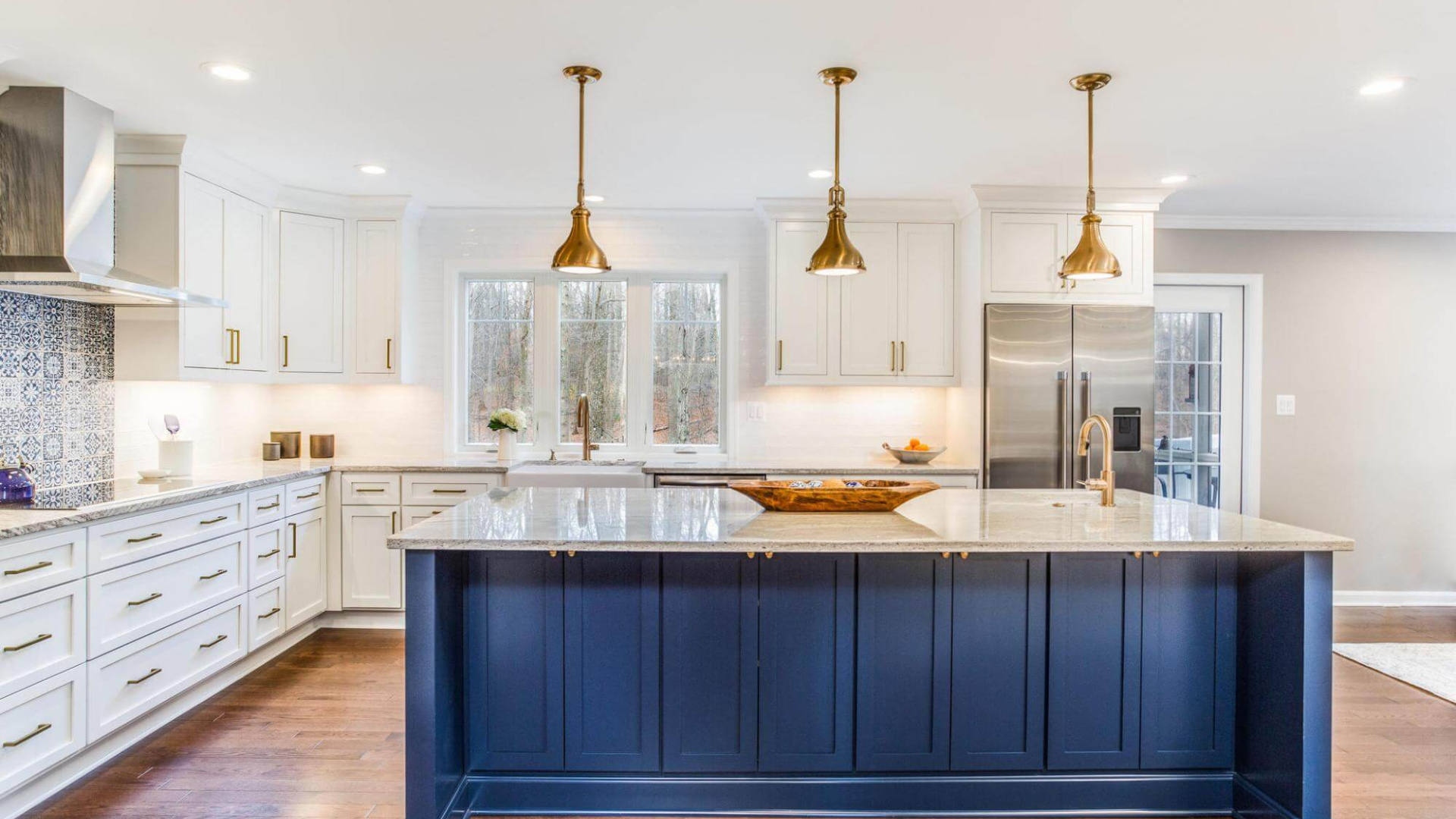Transitional kitchens have become a favorite for many homeowners, and it’s easy to see why.
They blend the clean, sleek feel of modern style with the cozy beauty of traditional design, giving you the best of both worlds.
In this blog, you’ll look at innovative design ideas that seamlessly blend smooth lines, natural textures, and timeless details.
If you’re struggling to mix old and new or want a space that feels both stylish and personal, this guide will help.
I know there’s no shortage of advice online. However, not all of it feels genuine or practical.
You’ll find ideas that genuinely work, ones I’d be proud to use in my kitchen.
If you choose one idea or several, you’ll find something that fits your space. Now, let’s begin with what a transitional kitchen really means.
What Is Transitional Kitchen Design?
A transitional kitchen mixes different styles in a way that feels just right.
You’ll see modern appliances and smooth surfaces paired with warm wood, soft colors, and simple trim details.
This balance creates a space that feels cozy without looking outdated, and clean without feeling too cold.
It’s a wise choice for families with busy routines or anyone working with smaller rooms or open layouts.
The style is flexible, allowing you to add new pieces over time without requiring a complete overhaul.
It grows with you as your taste and needs evolve. That makes it perfect for real life, where comfort and style need to work together every day.
Transitional Kitchen Designs
The following is a collection of ideas. Use them to update your space or start from scratch.
1. White Shaker Cabinets with Matte Black Hardware
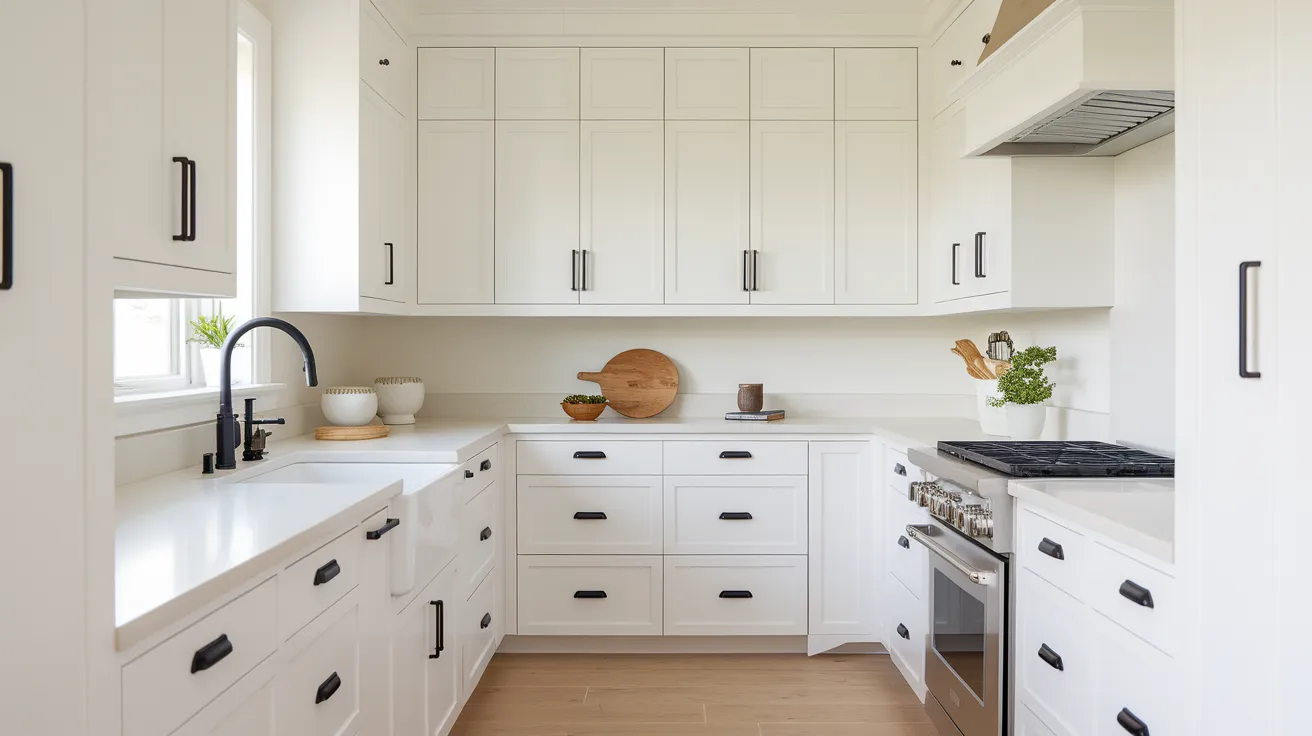
This combo creates a clean and timeless look that fits almost any kitchen style.
The soft white cabinets feel light and fresh, while the matte black handles add just the right amount of contrast.
This mix is easy to care for and looks great without needing bold colors or patterns. The black hardware helps define the space, making the design feel neat and finished.
It’s a wise choice if you want something simple that still has personality. Plus, it pairs well with nearly any countertop or flooring you choose.
2. Marble Backsplash with Wood Open Shelving
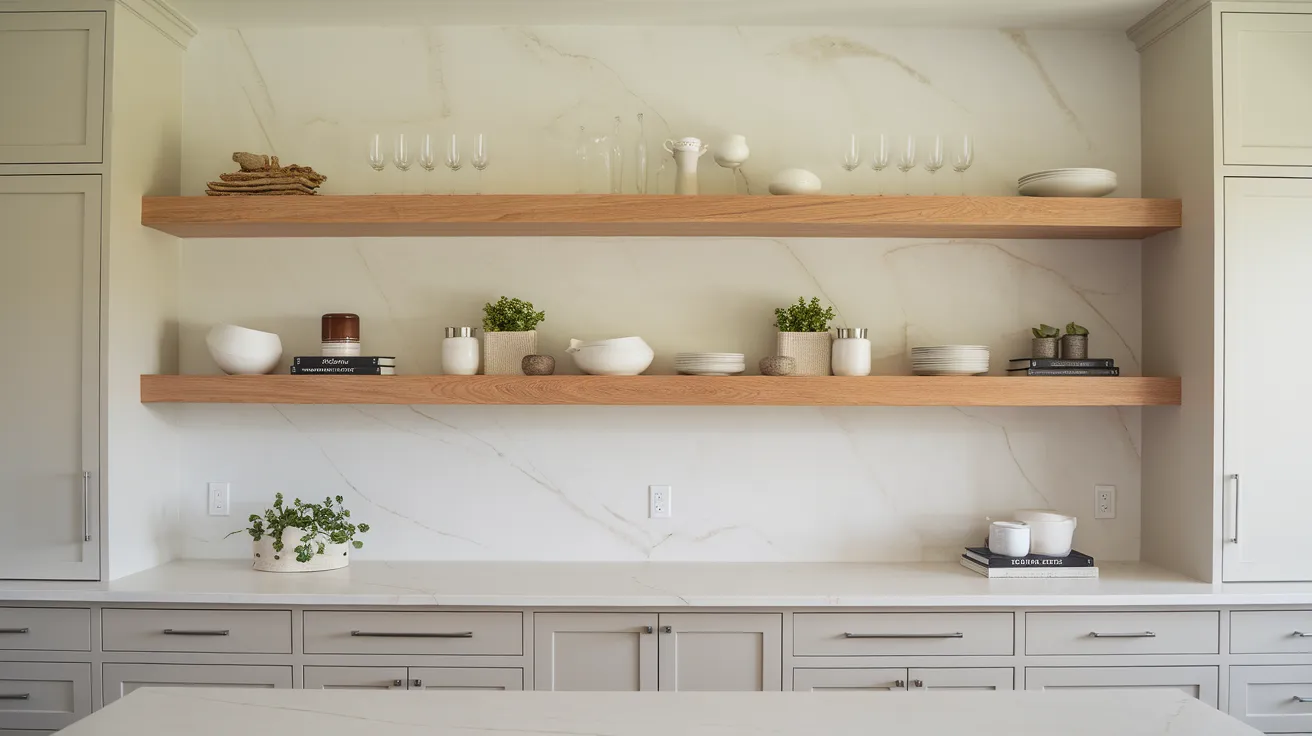
Pairing a marble backsplash with wood shelves creates a nice balance of clean and cozy in your kitchen.
The marble adds a crisp, polished surface that’s easy to wipe down.
The wood shelving adds a natural warmth and gives you the chance to showcase your favorite dishes or glassware.
This setup keeps your kitchen feeling open and airy. It works exceptionally well if you prefer a mix of modern and homey styles.
Additionally, it helps break up the monotony of too many cabinets and gives your wall a fresh, custom look.
3. Contrasting Island In Dark Green
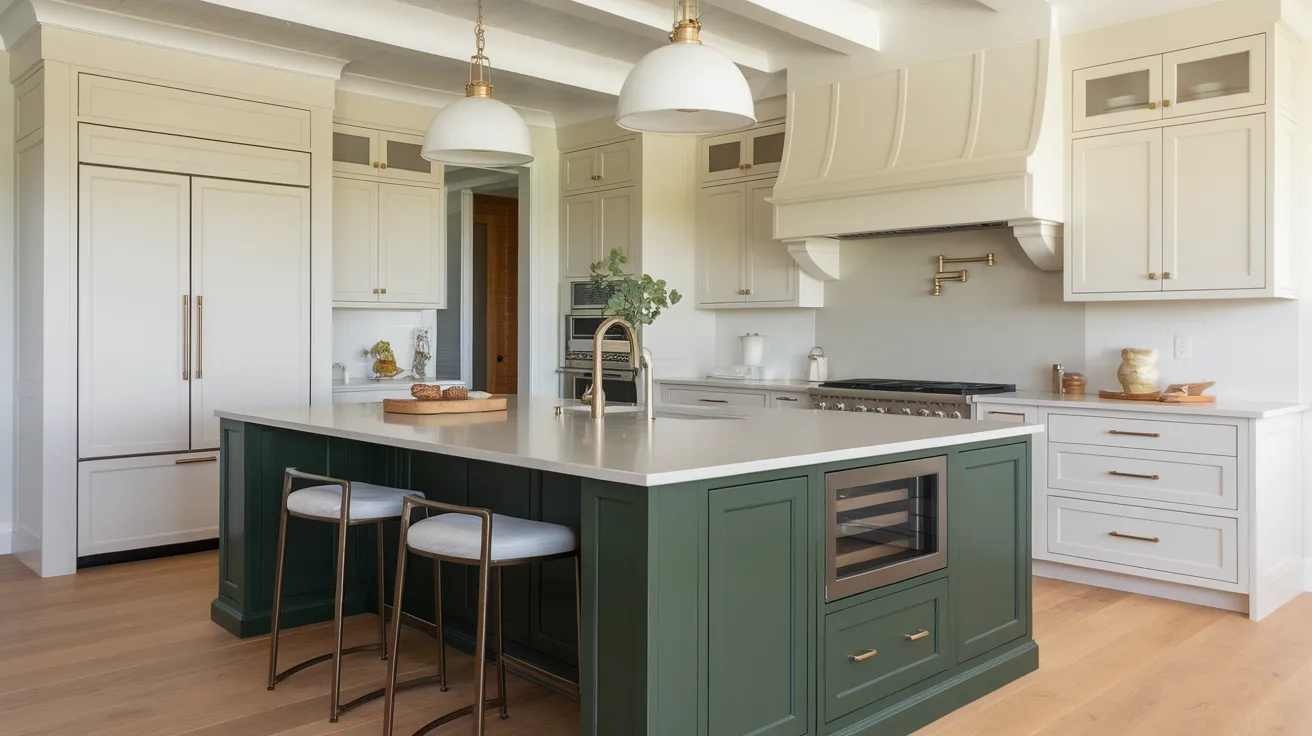
A dark green island adds color without being too bold. It becomes the focal point of your kitchen, especially when paired with lighter cabinets around it.
This color works well with various hardware, such as brass or nickel, and gives your kitchen a grounded, welcoming feel.
It brings a touch of nature without overwhelming the space. If you’re looking for a simple way to add character to your kitchen, a green island is a great place to start.
It looks great in both large and small kitchens.
4. Mix of Glass-Front and Solid Cabinetry
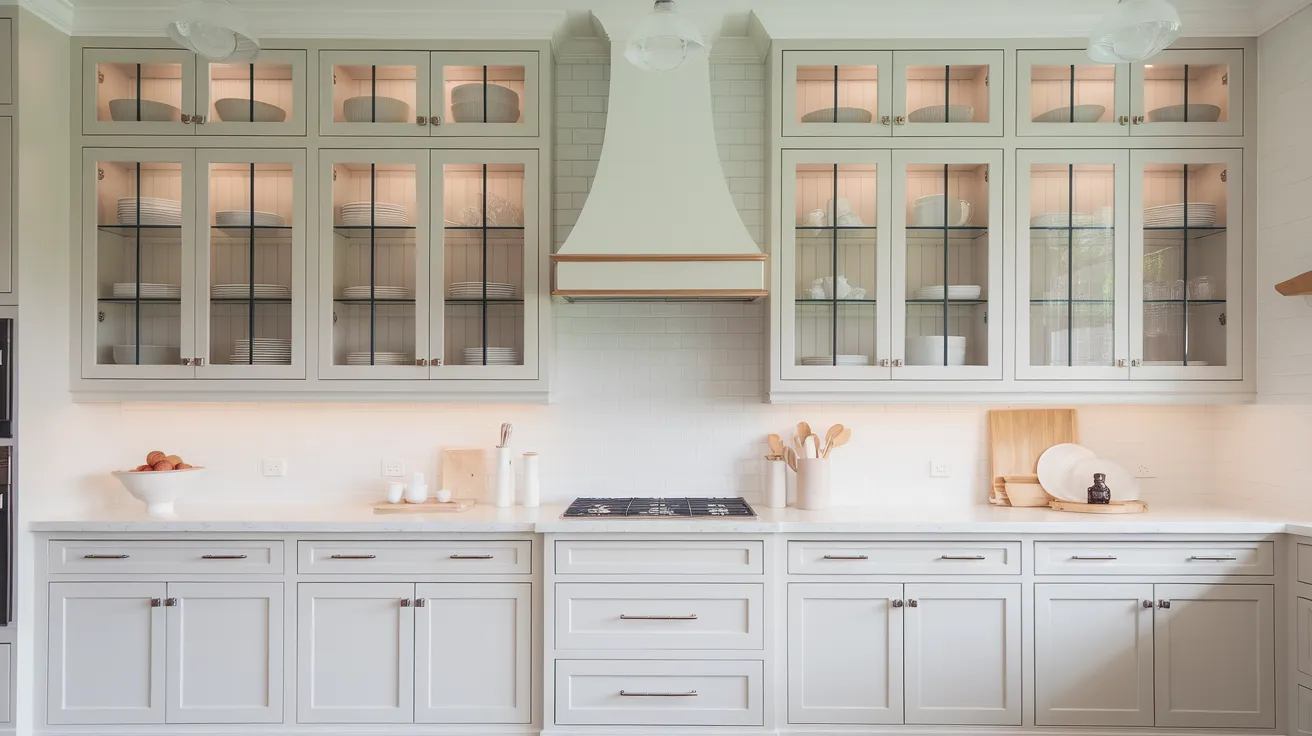
Combining glass-front cabinets with solid ones creates a smart, stylish balance.
Use glass fronts for upper cabinets to showcase your finest items. Then keep the lower ones solid for hidden storage.
This setup keeps things neat while adding a touch of personality. It also gives the space a more open feeling without losing storage.
You get to display your best dishes while keeping clutter out of sight. It’s a practical way to blend beauty with function in a transitional kitchen.
5. Brushed Gold Light Fixtures Over Island
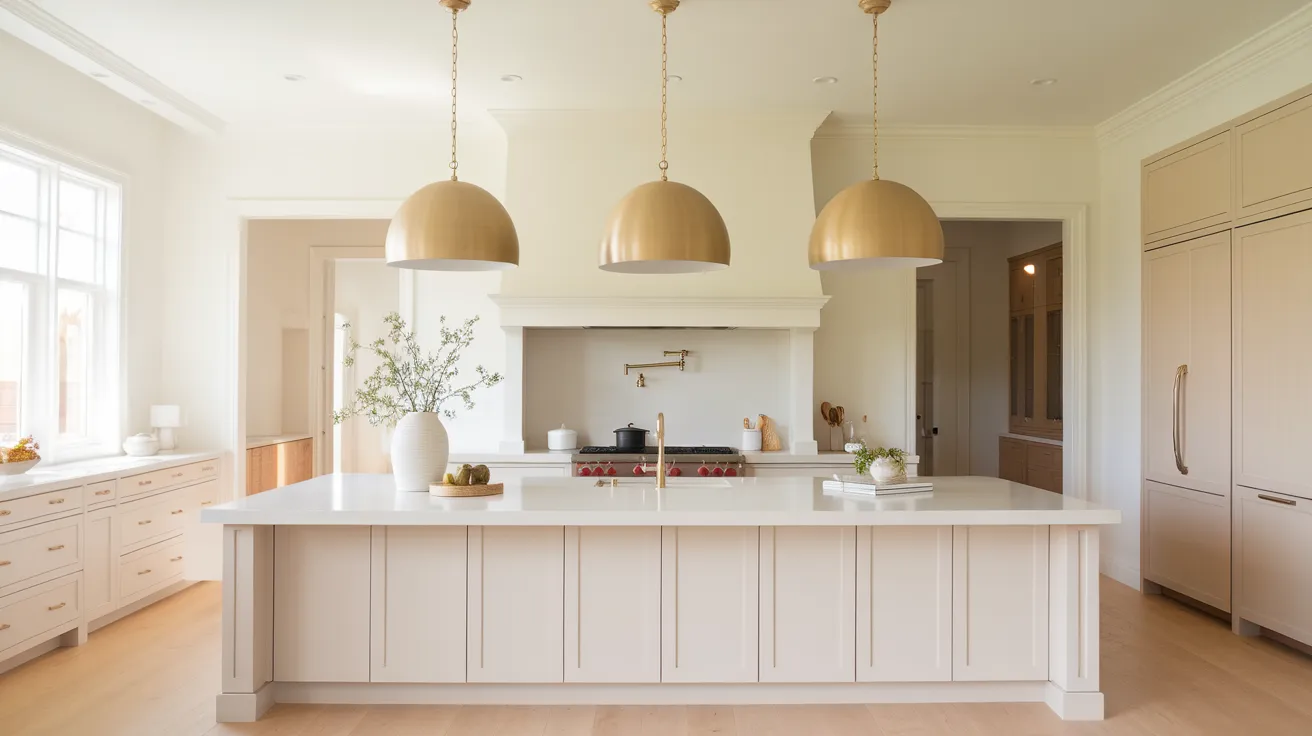
Brushed gold lighting adds just the right touch of shine without being too flashy.
It works beautifully with white, gray, green, or even wood finishes.
Over a kitchen island, these lights become a feature without dominating the entire space.
The soft gold tone adds warmth and blends easily with other finishes in your home.
It’s a simple way to make your kitchen feel a little more special. Plus, pendant lights over the island always add both style and function.
6. Waterfall Quartz Countertops
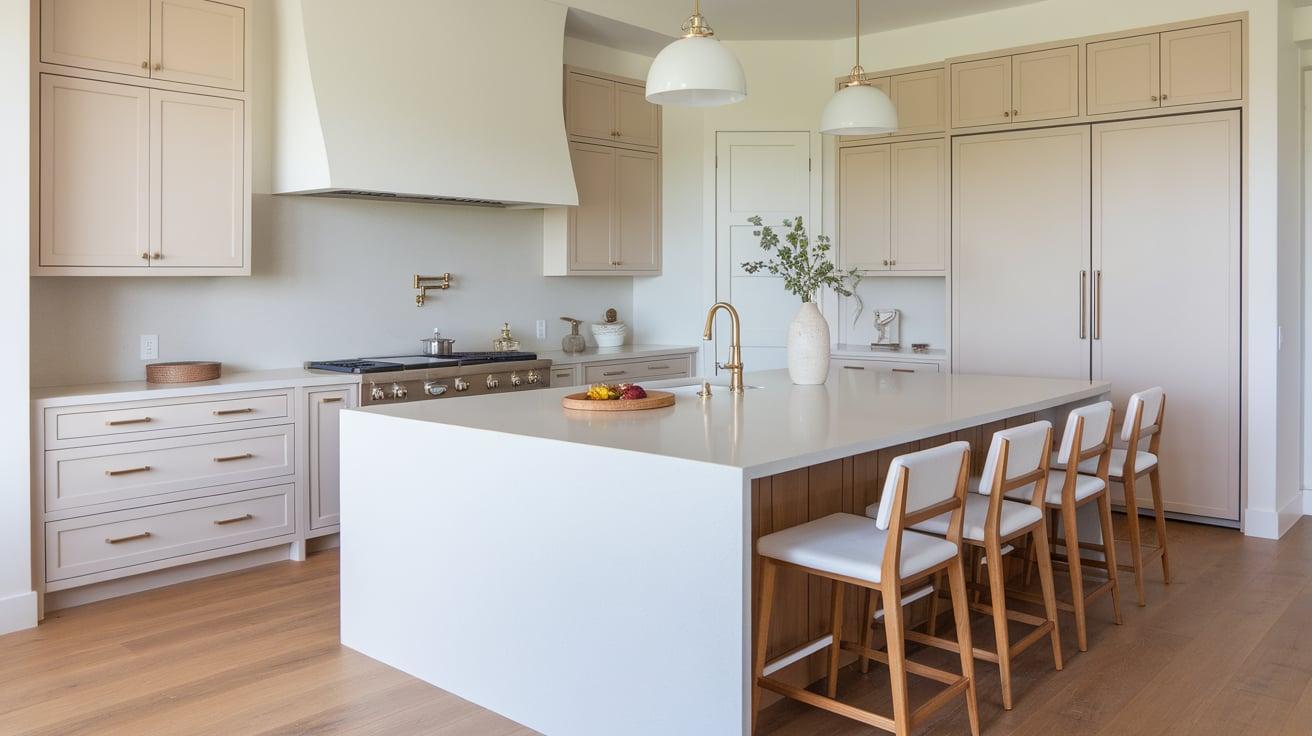
Waterfall countertops create a smooth, clean look by letting the quartz flow down the sides of the island.
This style looks modern but still fits in a cozy kitchen when paired with softer finishes.
Quartz is strong, easy to clean, and resistant to stains, making it ideal for busy households.
The waterfall edge adds a sleek touch without being too dramatic. It draws the eye and makes the island stand out in a quiet, polished way.
This choice works well if you want something that looks neat and stylish without requiring a lot of upkeep.
7. Integrated Appliances for a Clean Look
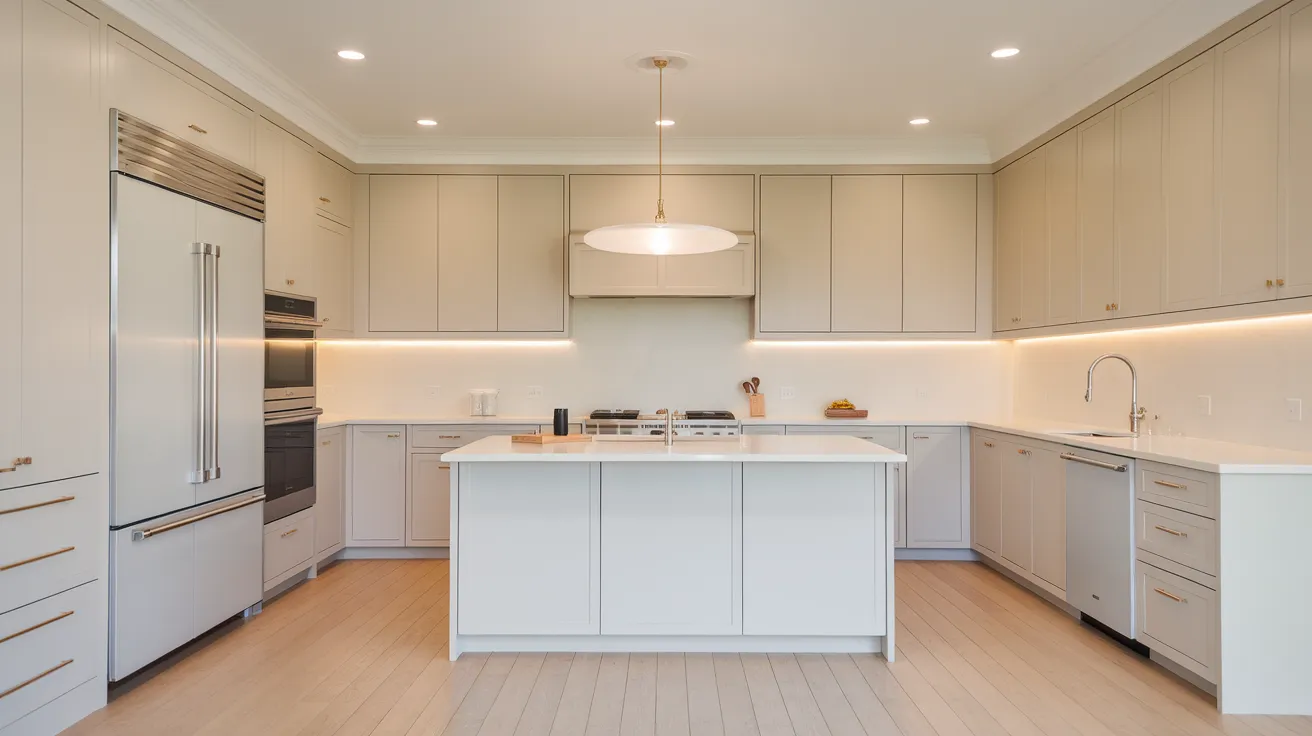
Integrated appliances help your kitchen feel smooth and organized.
The fridge, dishwasher, or even the oven can blend into your cabinets, so they don’t break up the flow of the design.
This makes the space feel more open and less cluttered. It’s beneficial in smaller kitchens or open layouts, where too many shiny surfaces can be distracting.
The style works with both modern and classic touches, so your space still feels warm. It keeps the focus on the kitchen’s overall look instead of the appliances.
8. Minimalist Bar Stools with Traditional Island Base
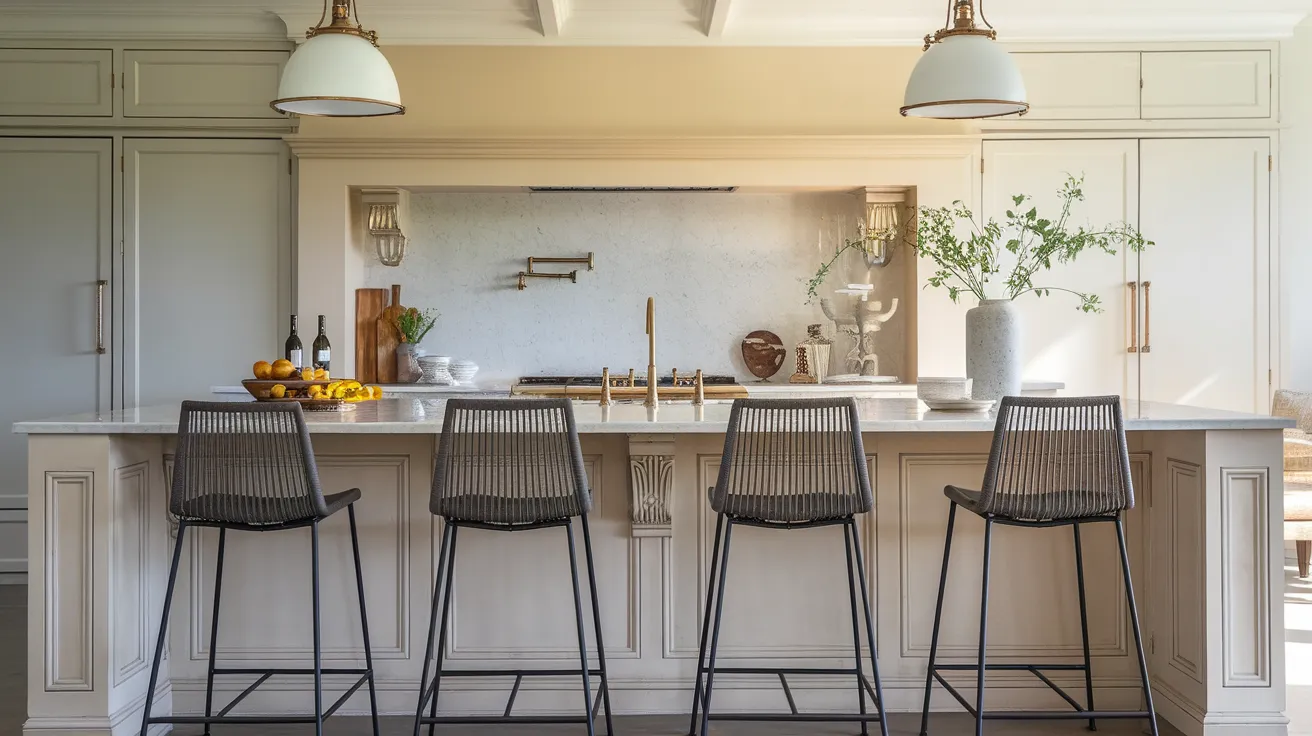
Slim, simple bar stools pair nicely with an island that has more classic details.
The contrast between modern seating and a detailed base gives the kitchen a balanced look.
The stools keep the area light and open, while the island base adds structure and style. This mix keeps the space from feeling too heavy or too plain.
It’s a great choice if you want your kitchen to feel fresh but still homey. It also allows you to easily update the space by changing the seating arrangement later.
9. Soft Gray Cabinets with Subway Tile Backsplash
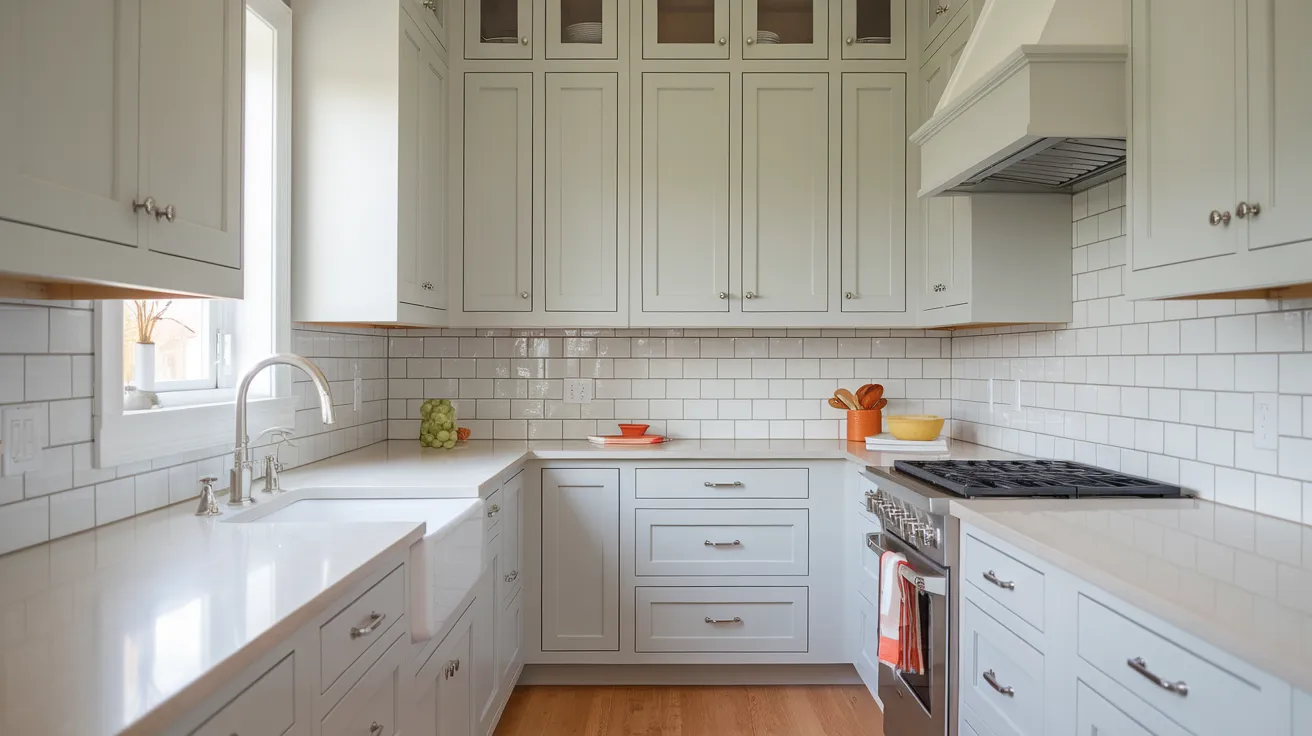
Soft gray cabinets add calm to your kitchen without making it feel dull. When paired with white subway tile, the result is a clean and simple design that still feels welcoming.
This combo works well in small kitchens because it keeps things light but adds just enough contrast.
The tile is easy to clean, and the gray hides wear better than bright white.
It’s a timeless style that gives you room to add color through dishes or decor. The whole look is neat, fresh, and easy to live with.
10. Warm Wood Floors with White Cabinetry
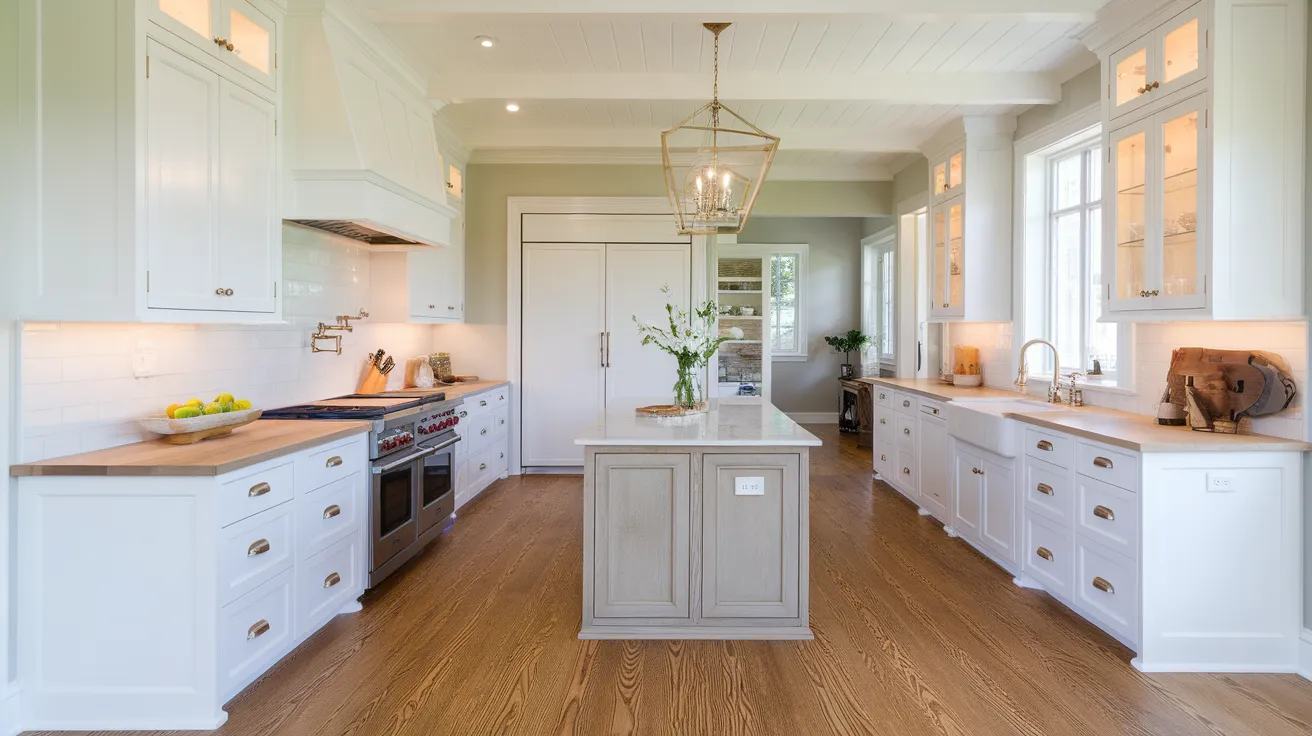
White cabinets and warm wood floors create a soft, balanced look. The wood brings in natural warmth, while the white maintains a bright and open look.
This combo works exceptionally well in open layouts, where the kitchen flows into dining or living areas.
The contrast between the floor and cabinets helps define the kitchen without the need for walls.
It’s a comfortable, classic style that makes the room feel clean yet warm. It also works well with almost any countertop or wall color.
11. Arched Doorway Into the Pantry
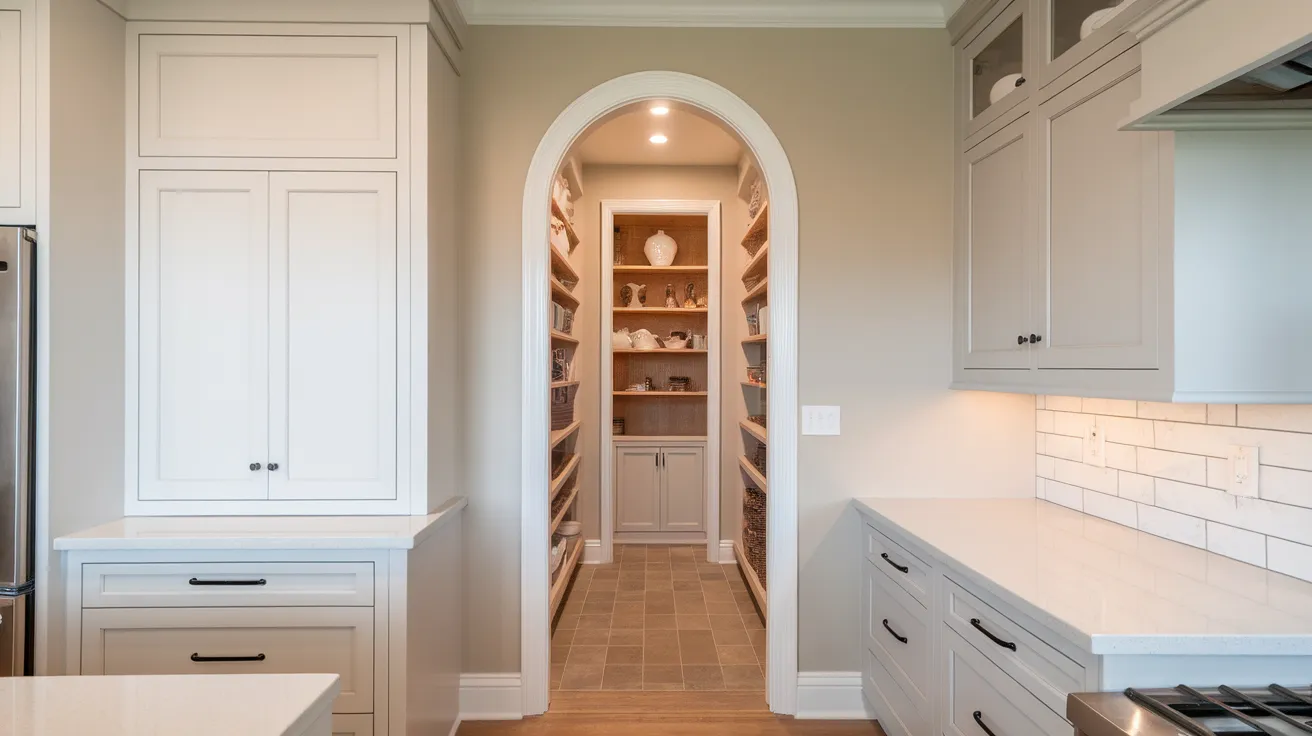
An arched doorway adds shape and beauty to a kitchen filled with straight lines.
It creates a soft transition into the pantry or another space, adding character to the room without being too bold.
Arches can make a space feel more custom and cozy. Even a simple arch draws attention and breaks up the hard edges around it.
You can highlight the arch with a different paint color or trim. It’s a small detail that makes a big difference to your overall kitchen design.
12. Traditional Crown Molding on Modern Cabinetry
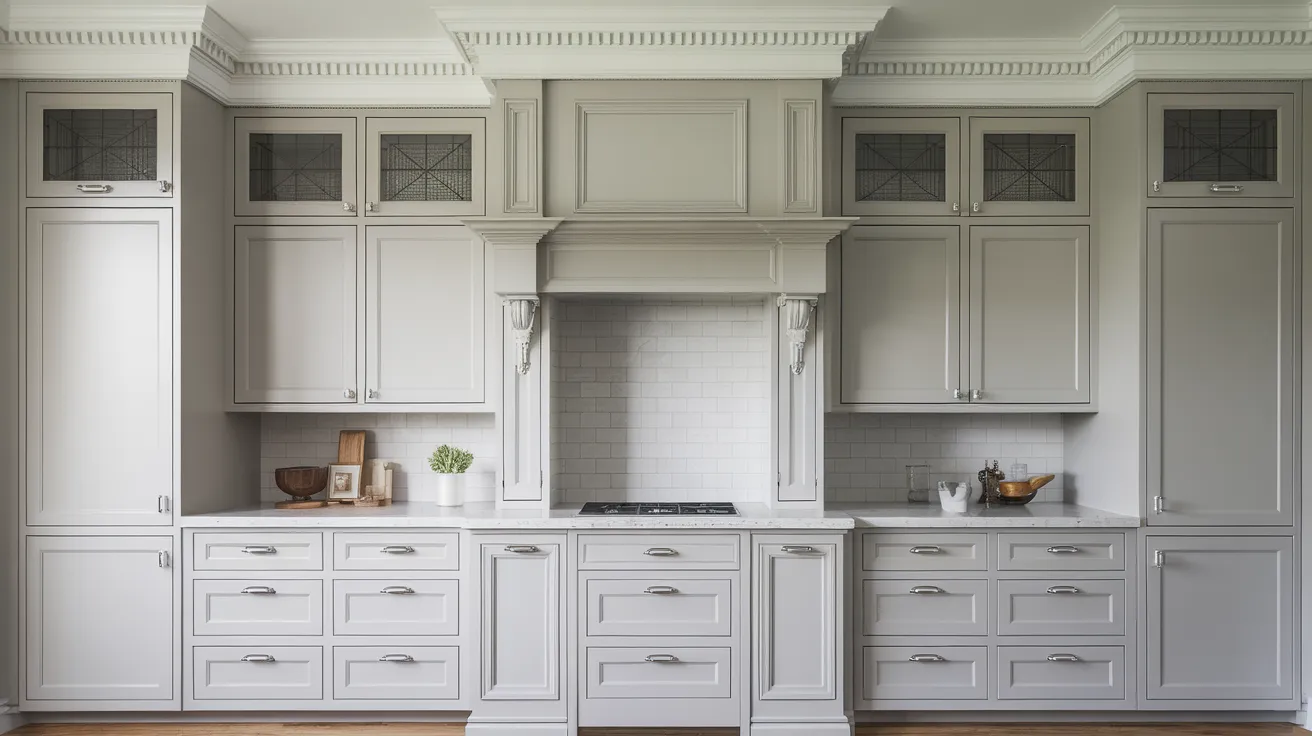
Crown molding adds warmth and structure, even when used on sleek, modern cabinets.
It helps bridge the gap between classic and current styles, which is precisely what transitional kitchens are all about.
The molding gives your upper cabinets a finished look and draws the eye upward, making the space feel taller.
It softens the sharp edges of flat cabinetry without taking away from the clean lines.
This blend makes your kitchen feel more complete and polished, while maintaining a simple design.
13. Two-Tone Cabinetry with Neutral Tones

Using two different tones for upper and lower cabinets breaks up the kitchen visually and adds depth.
Try pairing white uppers with light gray or taupe lowers. This soft contrast keeps things calm but adds enough interest to feel styled.
The split tones help ground the kitchen while making the top feel lighter. It’s a simple way to bring variety without using bold colors.
Additionally, it provides space to accentuate countertops, backsplashes, or hardware.
14. Sleek Pendant Lighting with Classic Trim
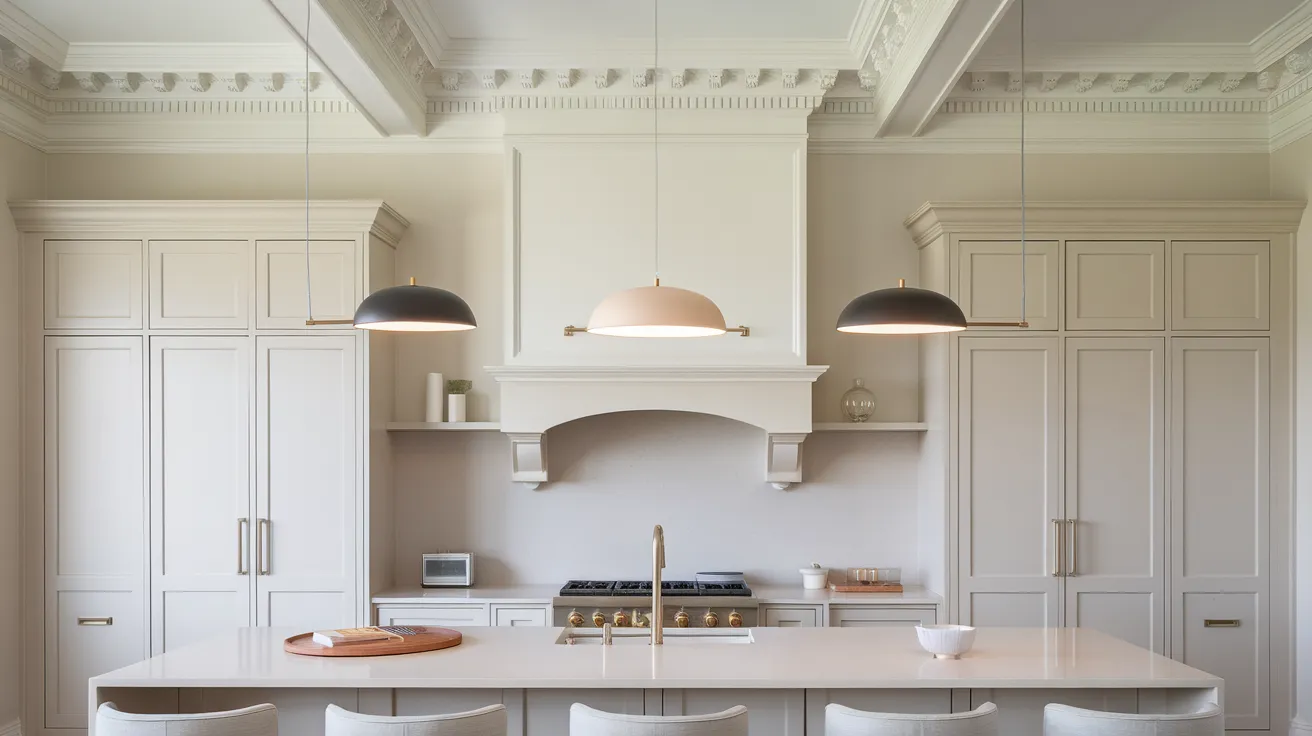
Pendant lights with clean, simple shapes pair beautifully with crown molding or base trim.
The mix of sleek lighting and detailed trim brings balance to your kitchen. It keeps the space from feeling too modern or too old-fashioned.
The lights become a quiet feature, while the trim adds a touch of tradition. This combo is great for transitional kitchens that want a mix of styles without clashing.
It works well over islands or dining spaces where design details matter.
15. Natural Stone Countertops with Modern Appliances

Stone countertops provide your kitchen with a strong, natural foundation.
They bring texture and weight, especially when paired with stainless steel or sleek built-in appliances.
The contrast creates a balanced look, grounded by the stone and brightened by the modern finishes. It’s great for people who want a kitchen that feels stylish but not too polished.
Natural stone can be the standout feature, while the appliances stay useful and updated. Together, they create a kitchen that feels both current and welcoming.
16. Textured Tile Behind Range Hood
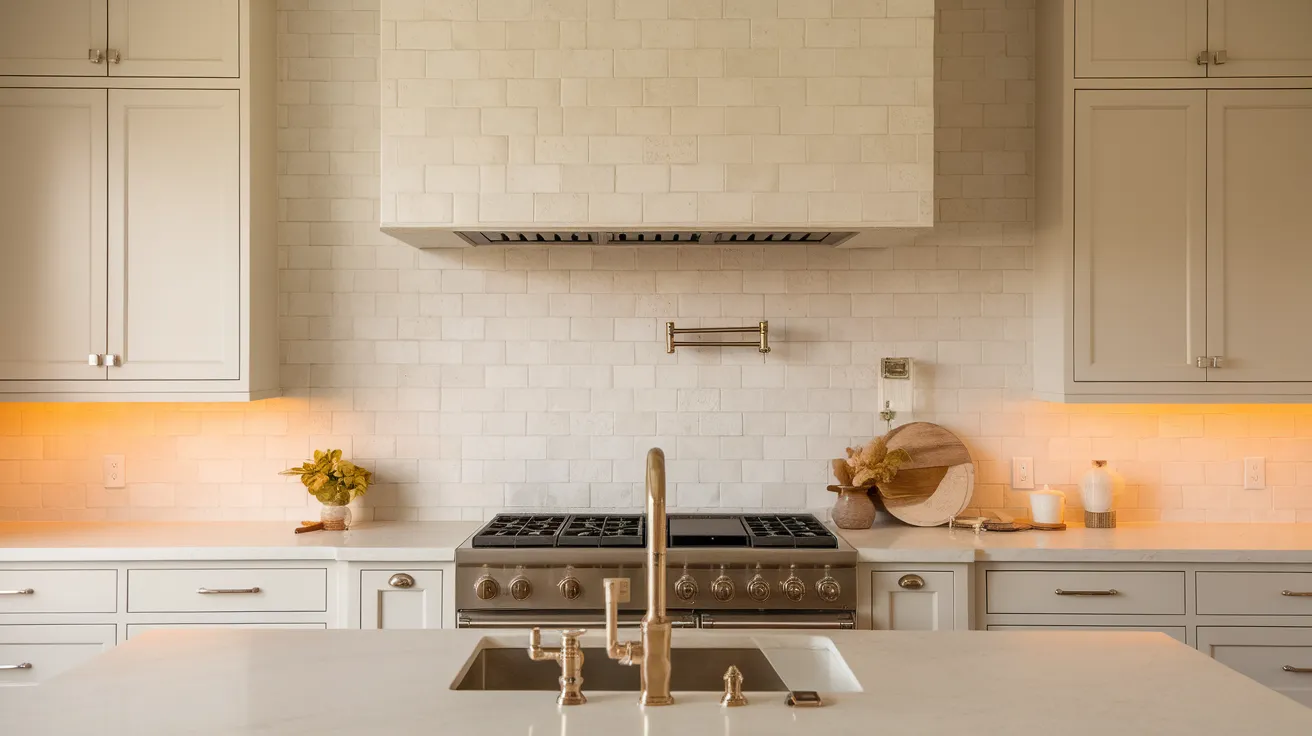
Adding textured tile behind the stove brings a great deal of interest to your kitchen.
It gives the wall a focal point without being too loud or busy. Choose a tile with a soft pattern or raised design in a neutral color.
This keeps the space calm while adding an extra visual element to look at. The texture complements smooth counters and cabinets nicely.
It’s a smart way to add detail without going overboard. Additionally, it makes the cooking area feel special without altering the entire kitchen.
17. Hidden Storage and Clever Cabinetry Solutions
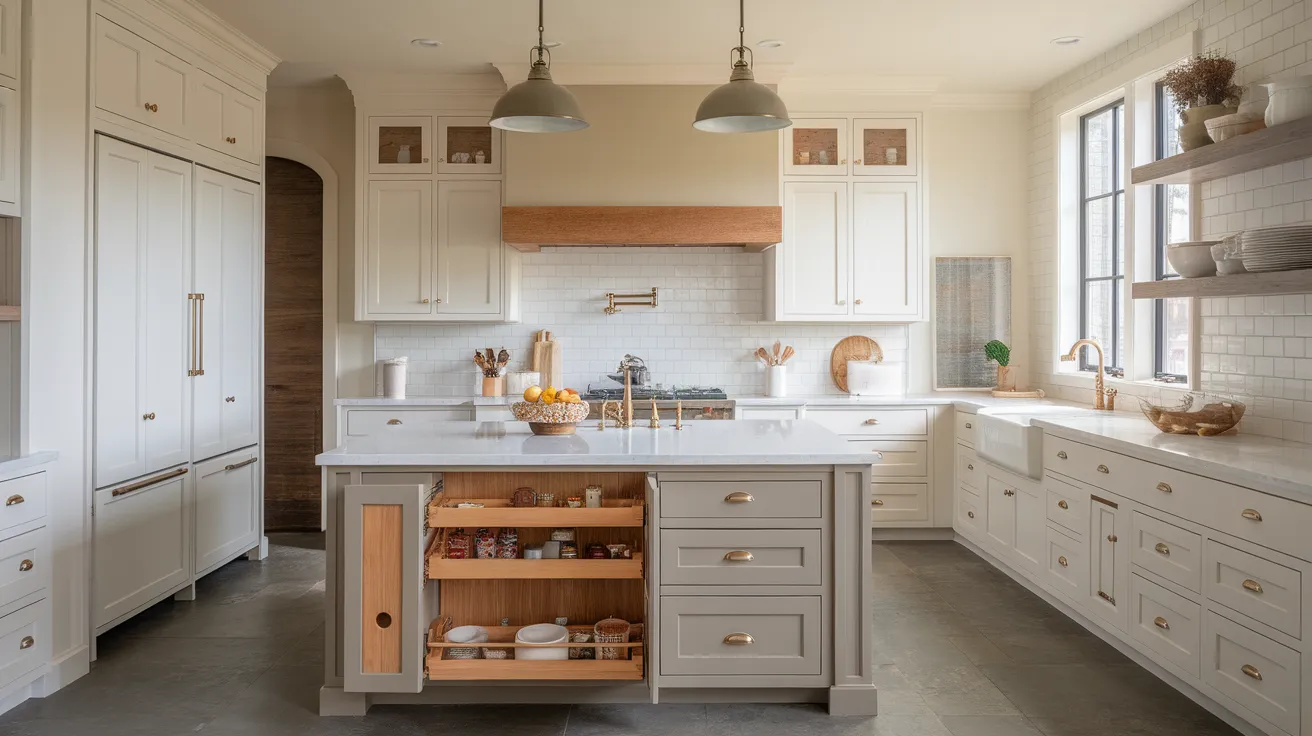
Smart storage enhances your kitchen’s functionality without compromising its appearance.
Utilize features such as pull-out shelves, toe-kick drawers, and dividers within cabinets.
These help you stay organized while keeping your countertops clear.
Hidden storage is beneficial in smaller kitchens, where every inch counts. It also keeps the kitchen looking neat and tidy, even when it’s in full use.
These solutions blend seamlessly with your design, allowing you to have function without sacrificing style.
It’s one of the easiest ways to make a big difference in your daily routine.
18. Statement Farmhouse Sink with Modern Faucet

A deep farmhouse sink provides ample space for large pots and dishes.
Its wide, smooth surface feels traditional, but it pairs well with a modern faucet for a fresh twist. The mix of old and new is exactly what transitional style is all about.
The sink becomes a focal point, while the faucet keeps it updated. Select a faucet with a simple, clean shape and lines.
This pairing makes your kitchen more functional and adds a bold feature that doesn’t overwhelm the space.
19. Slab Cabinet Doors In Muted Tones
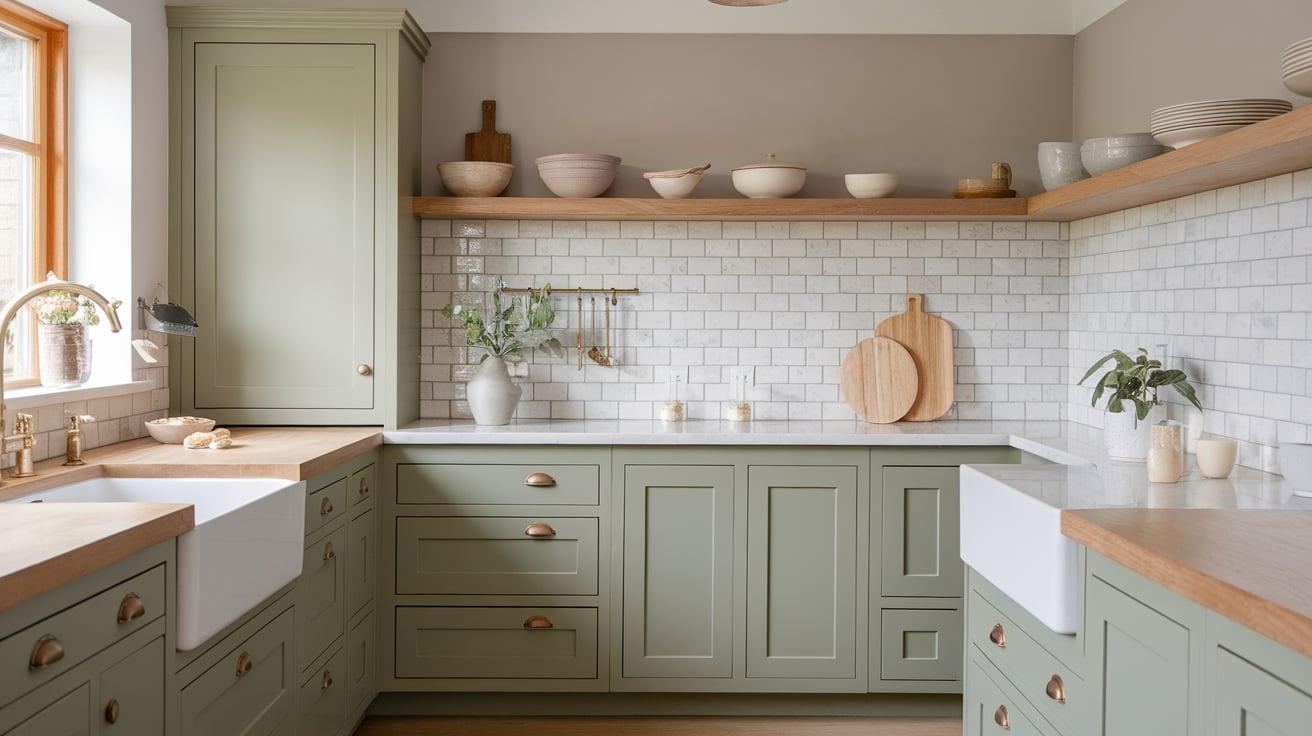
Flat-panel or slab doors give your cabinets a clean, modern face.
When done in muted tones like sage, beige, or clay, they keep the room feeling calm and relaxed. These colors add just the right amount of personality without being too loud.
The smooth surfaces are also easy to clean, making them ideal for everyday use.
This style works well with both metal and wood accents, so you can add warmth or shine as needed.
Slab doors in soft shades add a quiet, stylish edge to your kitchen that lasts.
20. Classic Hardware In Brushed Nickel

Brushed nickel hardware is a reliable choice that never feels out of place. It matches almost any cabinet color or countertop finish.
The soft metal tone adds a touch of shine without being too bright or flashy.
It’s a safe middle ground between modern and traditional, making it perfect for transitional kitchens.
You can use it on both drawers and doors for a uniform look. This hardware also resists fingerprints and smudges, which helps your space stay clean and polished.
21. Neutral Palettes with Rich Wood Accents
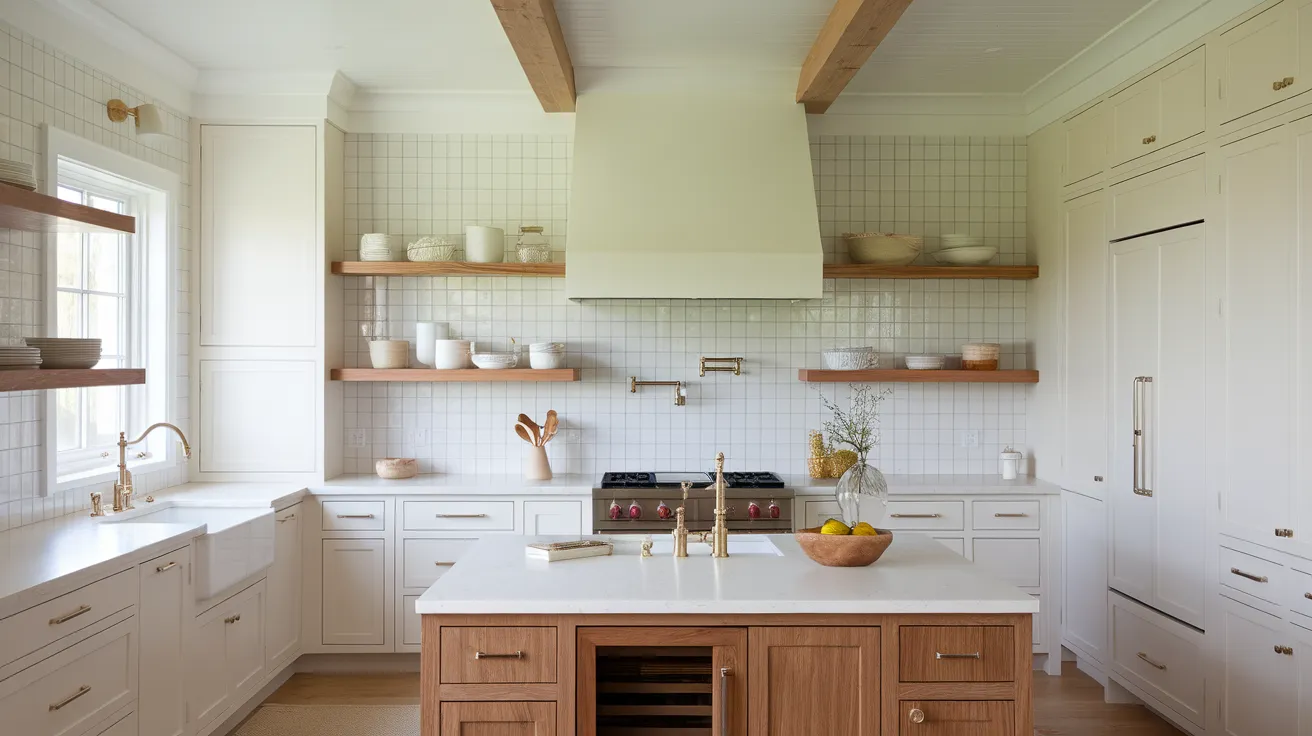
Starting with a base of whites, creams, or grays gives your kitchen a calm foundation.
Adding wood tones, such as walnut or oak, brings warmth and character. This contrast helps the kitchen feel lived-in without losing its clean style.
The wood can come from open shelves, beams, or even lower cabinets. It adds depth and keeps the space from feeling flat.
You get the benefit of a soft, flexible color scheme with just enough boldness to make it enjoyable.
22. Transitional Coffered Ceiling Design
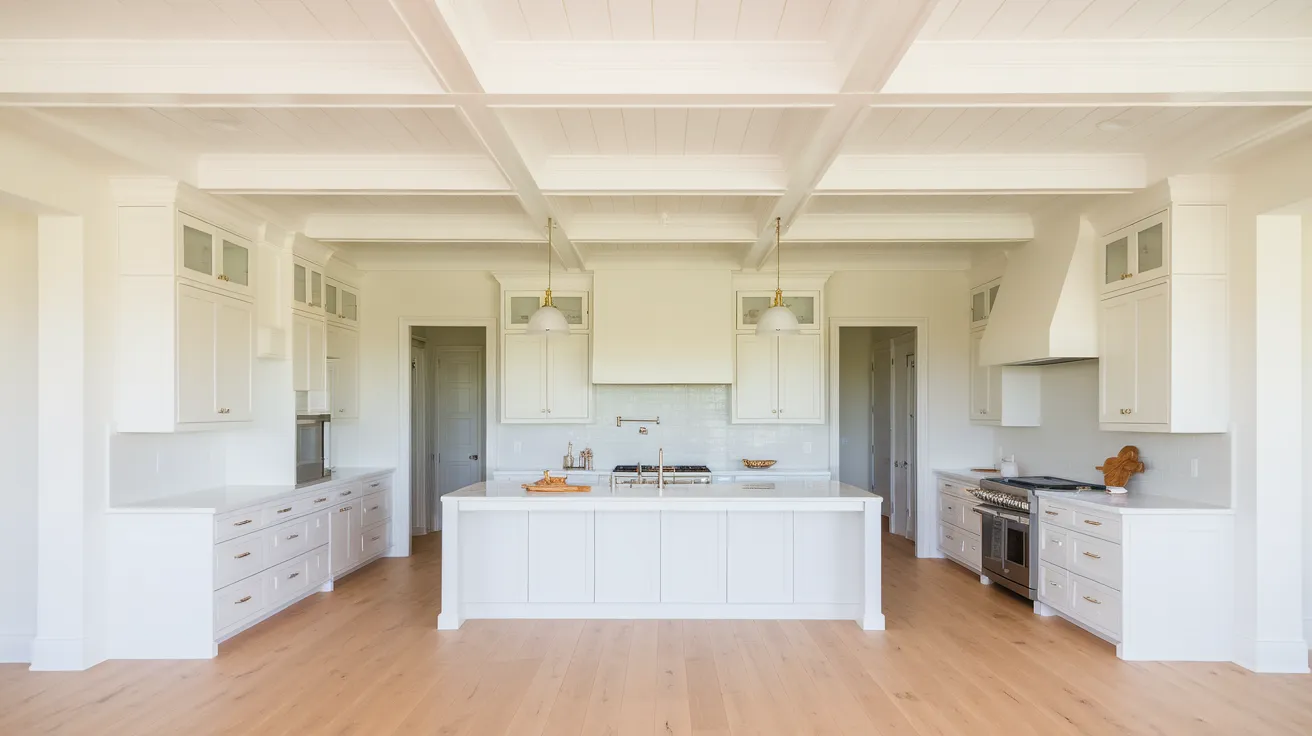
A coffered ceiling adds shape and interest without making the room feel too heavy.
The square beams draw your eye up and make the space feel more complete. In a transitional kitchen, the beams can be kept simple and painted to match the ceiling.
This helps the detail blend in while still adding texture. It’s a subtle feature that works exceptionally well in open layouts.
It adds style to your kitchen ceiling without making the room feel crowded or busy.
23. Classic Lantern Lights Over Sleek Kitchen Island
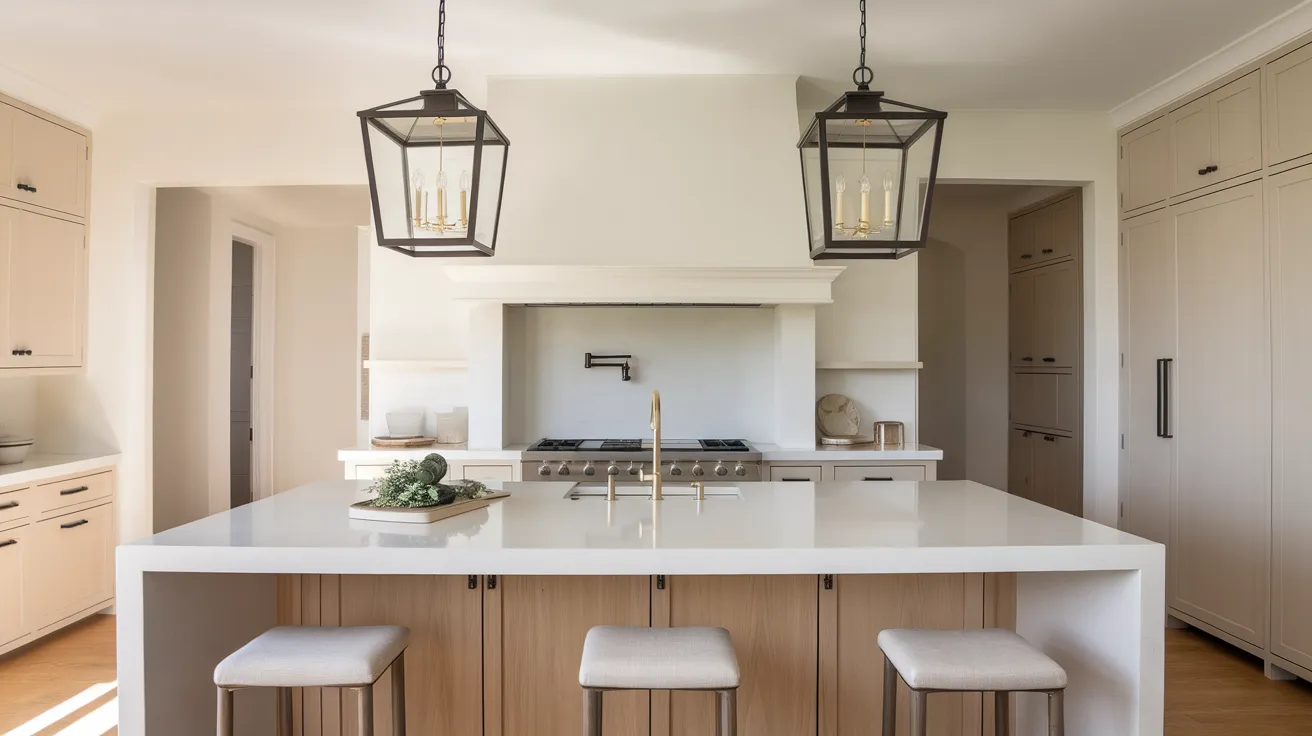
Lantern-style light fixtures bring a soft, welcoming glow to your kitchen.
When placed over a sleek, simple island, they create a strong contrast that feels balanced.
The lanterns add beauty and personality without making the space look old-fashioned. They work well in pairs or sets of three, especially over larger islands.
Their shapes are interesting but not overwhelming. This pairing makes the lighting feel more like decor, while still giving you the brightness you need for daily use.
24. Reclaimed Wood Beams with Clean White Designs
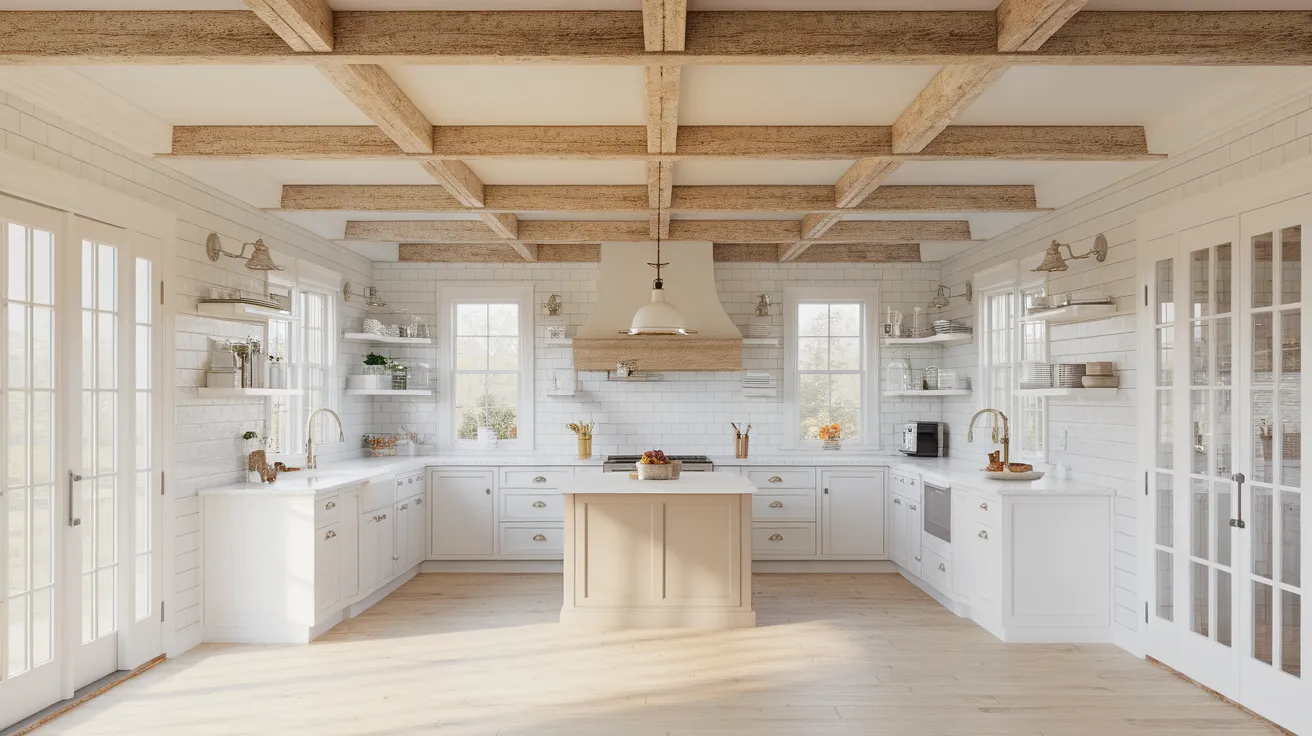
Adding old wood beams to a kitchen with white cabinets or walls creates a perfect mix of rustic and fresh.
The beams add texture and a sense of history, while the clean, white background keeps everything feeling open and bright.
This contrast draws attention to the ceiling and adds personality to the space. It works well in open-concept homes where the kitchen needs to feel both cozy and modern.
It’s a simple way to bring warmth without adding clutter.
25. Mix of Natural and Industrial Textures
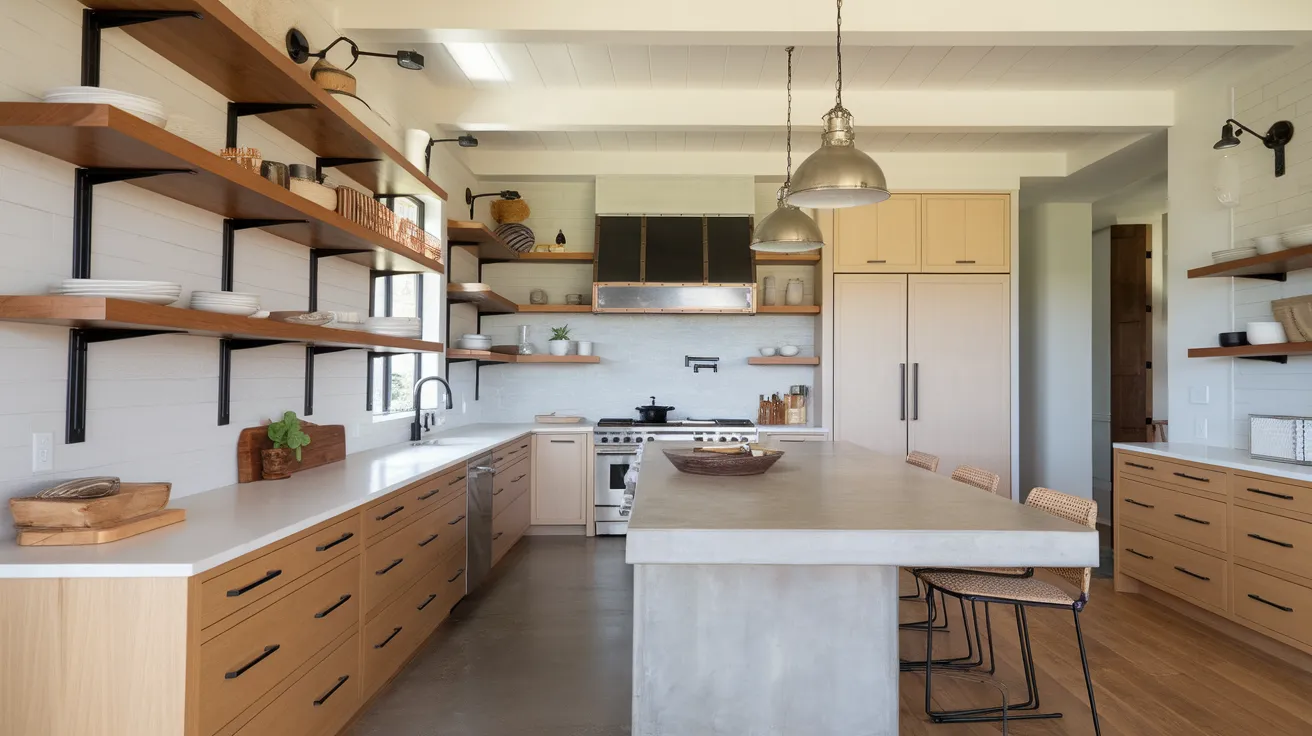
Blending wood with materials like metal, glass, or cement gives your kitchen a unique look.
This mix strikes a balance that keeps the space from feeling too polished or too raw.
For example, you could pair wooden shelves with metal brackets, or use concrete-style counters with soft-toned cabinets.
This contrast adds depth and helps the kitchen feel personal.
It works exceptionally well if you like a look that feels current but not too trendy. The key is finding the right balance between soft and firm.
26. Open Concept Layout with Stylish Cabinetry
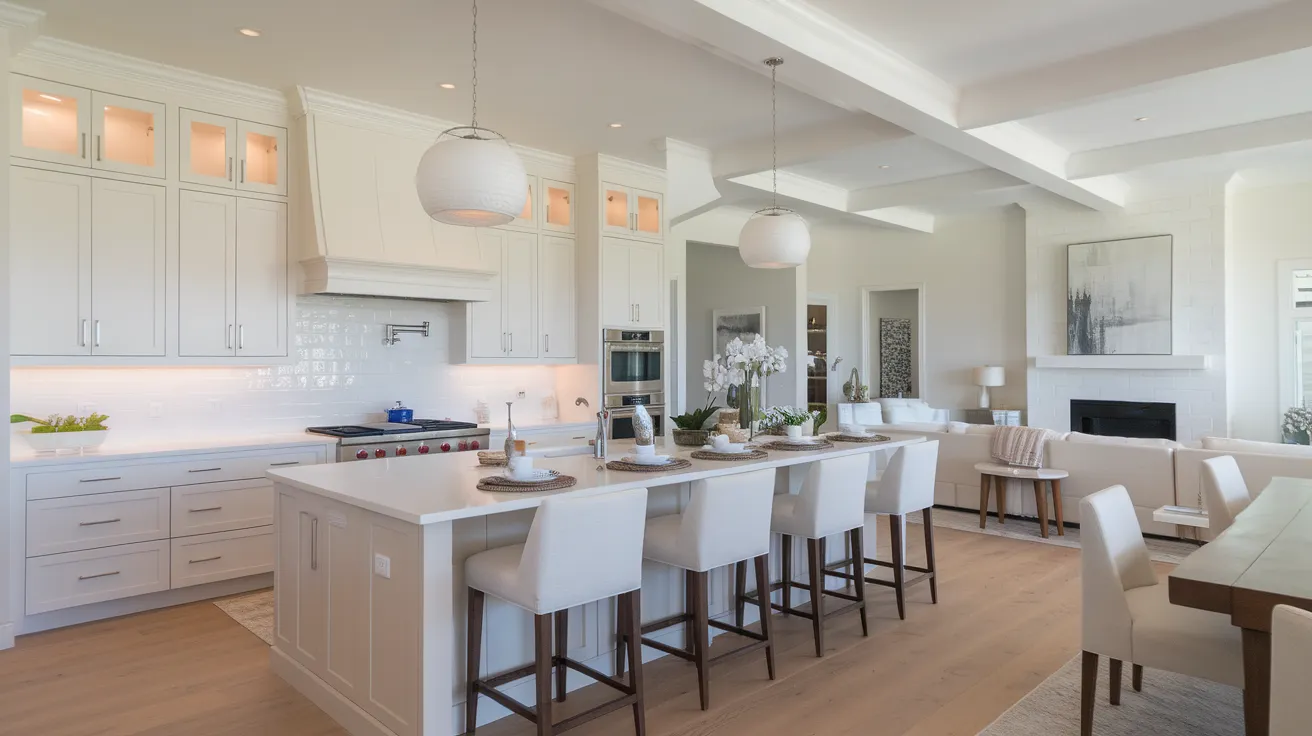
Allowing your kitchen to flow seamlessly into nearby spaces keeps your home feeling connected.
When cabinets are stylish and well-designed, they look great from every angle. This is particularly important in open layouts, where your kitchen is always visible.
Select simple lines, high-quality finishes, and colors that complement the rest of your home. The goal is to create a kitchen that feels like an integral part of your living space.
This approach keeps things open while still feeling thoughtful and finished.
27. Soft-Close Drawers with Ornate Moldings

Soft-close drawers make your kitchen more comfortable to use every day. They shut quietly and smoothly, which helps avoid slamming or damage.
When paired with detailed moldings on the drawers or cabinets, you get a perfect mix of function and style.
The moldings give the kitchen a more traditional touch, while the drawer hardware keeps it feeling modern.
This combination works well in homes that desire luxury without being overly extravagant. It’s a quiet detail that adds lasting comfort.
Tips for Achieving a Transitional Kitchen Design In Your Own Home
The following are the things you need to keep in mind when implementing a transitional kitchen design in your space:
- Stick with soft tones and pair them with one bold element.
- Mix smooth and textured finishes (like glass and wood).
- Avoid going too modern or too vintage; balance is the key.
- Use warm lighting to create a soft, inviting atmosphere.
- Keep open shelves tidy or limit the number of items you use.
- Choose one standout piece: a light, an island, or a sink, and let the rest support it.
Conclusion
A transitional kitchen isn’t just about its appearance; it’s also about how it feels when you cook, gather, and move through the space.
It should welcome you each day, fit seamlessly into your routine, and showcase your unique taste.
Even minor updates can make a big difference. You don’t need to tear everything out.
Try using one or two of these ideas to give your kitchen a fresh, balanced feel without doing a complete remodel.
So, what caught your eye? Which idea would you want to try first? Share your thoughts in the comments below.
I’d love to hear what inspires you and learn more about your design style as well. Your ideas might help someone else find their perfect look!

